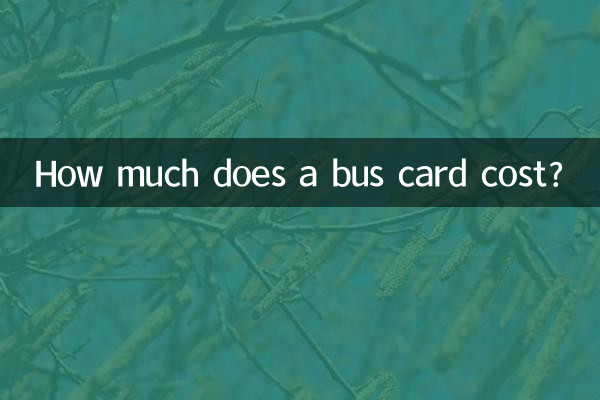How much does a bus card cost: analysis of hot topics and hot content across the Internet
In the past 10 days, the discussion about bus card fees has become one of the hot topics. From the price adjustment of bus cards in various places to the popularization of new payment methods, netizens' concern for this daily travel tool has increased significantly. This article will provide you with a detailed analysis of the cost of bus cards based on hot topics across the entire network, and attach structured data for reference.
1. Comparison of single-trip fares for bus cards in major cities across the country

| City | Ordinary card price (yuan) | Student card price (yuan) | Senior card price (yuan) |
|---|---|---|---|
| Beijing | 2.00 | 1.00 | free |
| Shanghai | 2.00 | 1.00 | free |
| Guangzhou | 2.00 | 1.00 | free |
| Shenzhen | 2.50 | 1.25 | free |
| Chengdu | 2.00 | 1.00 | free |
| Wuhan | 2.00 | 1.00 | free |
2. Recent hot discussions about bus cards
1.Mobile payment impacts traditional bus cards: With the popularity of mobile payment methods such as Alipay and WeChat, public transportation systems in many places have begun to support scanning QR codes with mobile phones to board the bus. This change has caused many netizens to question whether traditional bus cards are still necessary.
2.Bus card deposit issue sparks controversy: Some cities charge deposits ranging from 20 to 30 yuan for bus cards, causing consumer dissatisfaction. Some netizens pointed out that the total amount of deposits that have not been refunded for many years is huge and called on relevant departments to strengthen supervision.
3.Remote communication has become a new demand: As exchanges between cities become increasingly frequent, netizens have an increasingly strong demand for national interoperability of bus cards. At present, more than 300 cities across the country have implemented transportation card interconnection.
4.Increased preferential treatment for special groups: Many places have introduced policies to expand the age range and discounts for special groups such as the elderly and disabled people to ride free of charge. This initiative has been widely praised.
3. Cost analysis of bus card usage
| Fee type | Amount (yuan) | illustrate |
|---|---|---|
| Card application cost | 20-30 | Most cities charge a refundable deposit |
| single ride | 1.0-2.5 | Ordinary card price |
| average monthly expenses | 80-200 | Calculated based on 2 times a day |
| annual expenditure | 960-2400 | Calculated based on 12 months |
4. Forecast of future development trends of bus cards
1.Digitalization process accelerates: It is expected that in the next three years, physical bus cards will be gradually replaced by virtual cards, and mobile NFC and QR code payment will become mainstream.
2.The price system becomes more flexible: More refined charging models such as mileage-based charging and differential pricing during peak hours may appear.
3.Cross-city interconnection develops in depth: The coverage of the national transportation card will continue to increase, realizing "one card to travel across the country" in the true sense.
4.Value-added service expansion: Bus cards may integrate more city service functions, such as micropayments, identity authentication, etc.
5. Suggestions for use
1. According to the preferential policies of the city where you are located, apply for the corresponding preferential cards in a timely manner.
2. Pay attention to the official information of the local bus group to learn about the latest fare adjustments and changes in payment methods.
3. For people who don’t often use public transportation, mobile payment can be given priority to avoid deposits.
4. When traveling across cities, check in advance whether the destination supports joint transportation cards to avoid repeated ticket purchases.
It can be seen from the above analysis that although the single cost of a bus card seems not high, long-term use is also a considerable expense. With technological advancement and urban development, public transportation payment methods are undergoing profound changes. It is recommended that citizens choose the most suitable travel payment solution based on their own needs.

check the details

check the details